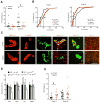Endothelial heparan sulfate controls chemokine presentation in recruitment of lymphocytes and dendritic cells to lymph nodes
- PMID: 21093315
- PMCID: PMC2996097
- DOI: 10.1016/j.immuni.2010.10.018
Endothelial heparan sulfate controls chemokine presentation in recruitment of lymphocytes and dendritic cells to lymph nodes
Erratum in
- Immunity. 2011 May 27;34(5):820. Petryanik, Bronislawa [corrected to Petryniak, Bronislawa]
Abstract
Heparan sulfate can bind several adhesion molecules involved in lymphocyte trafficking. However, the in vivo function of endothelial heparan sulfate in lymphocyte homing and stimulation of the immune response has not been elucidated. Here, we generated mutant mice deficient in the enzyme Ext1, which is required for heparan sulfate synthesis, in a Tek-dependent and inducible manner. Chemokine presentation was diminished in the mutant mice, causing the lack of appropriate integrin-mediated adhesion, and resulted in a marked decrease in lymphocyte sticking to high endothelial venules and in recruitment of resident dendritic cells through lymphatic vessels to the lymph nodes. As a consequence, mutant mice displayed a severe impairment in lymphocyte homing and a compromised contact hypersensitivity response. By contrast, lymphocyte rolling was increased because of loss of electrostatic repulsion by heparan sulfate. These results demonstrate critical roles of endothelial heparan sulfate in immune surveillance and immune response generation.
Copyright © 2010 Elsevier Inc. All rights reserved.
Figures







Comment in
-
Trapped versus soluble chemokines: functions in leukocyte adhesion and motility.Immunity. 2010 Nov 24;33(5):654-6. doi: 10.1016/j.immuni.2010.11.012. Immunity. 2010. PMID: 21094462
Similar articles
-
Role of high endothelial venule-expressed heparan sulfate in chemokine presentation and lymphocyte homing.J Immunol. 2013 Jul 1;191(1):448-55. doi: 10.4049/jimmunol.1203061. Epub 2013 Jun 3. J Immunol. 2013. PMID: 23733868 Free PMC article.
-
Lymphatic specific disruption in the fine structure of heparan sulfate inhibits dendritic cell traffic and functional T cell responses in the lymph node.J Immunol. 2014 Mar 1;192(5):2133-42. doi: 10.4049/jimmunol.1301286. Epub 2014 Feb 3. J Immunol. 2014. PMID: 24493818 Free PMC article.
-
A critical role for lymphatic endothelial heparan sulfate in lymph node metastasis.Mol Cancer. 2010 Dec 20;9:316. doi: 10.1186/1476-4598-9-316. Mol Cancer. 2010. PMID: 21172016 Free PMC article.
-
The role of heparan sulphate in inflammation.Nat Rev Immunol. 2006 Sep;6(9):633-43. doi: 10.1038/nri1918. Epub 2006 Aug 18. Nat Rev Immunol. 2006. PMID: 16917509 Review.
-
Roles of sulfated glycans in lymphocyte homing.Biol Pharm Bull. 2006 Dec;29(12):2343-9. doi: 10.1248/bpb.29.2343. Biol Pharm Bull. 2006. PMID: 17142960 Review.
Cited by
-
Biochemical evidence for superior correction of neuronal storage by chemically modified enzyme in murine mucopolysaccharidosis VII.Proc Natl Acad Sci U S A. 2012 Oct 16;109(42):17022-7. doi: 10.1073/pnas.1214779109. Epub 2012 Oct 1. Proc Natl Acad Sci U S A. 2012. PMID: 23027951 Free PMC article.
-
Initial afferent lymphatic vessels controlling outbound leukocyte traffic from skin to lymph nodes.Front Immunol. 2013 Dec 9;4:433. doi: 10.3389/fimmu.2013.00433. Front Immunol. 2013. PMID: 24368908 Free PMC article. Review.
-
Increased migration of antigen presenting cells to newly-formed lymphatic vessels in transplanted kidneys by glycol-split heparin.PLoS One. 2017 Jun 30;12(6):e0180206. doi: 10.1371/journal.pone.0180206. eCollection 2017. PLoS One. 2017. PMID: 28665959 Free PMC article.
-
Molecular functions of syndecan-1 in disease.Matrix Biol. 2012 Jan;31(1):3-16. doi: 10.1016/j.matbio.2011.10.001. Epub 2011 Oct 18. Matrix Biol. 2012. PMID: 22033227 Free PMC article. Review.
-
The integration of T cell migration, differentiation and function.Nat Rev Immunol. 2013 May;13(5):309-20. doi: 10.1038/nri3442. Epub 2013 Apr 19. Nat Rev Immunol. 2013. PMID: 23598650 Review.
References
-
- Arbones ML, Ord DC, Ley K, Ratech H, Maynard-Curry C, Otten G, Capon DJ, Tedder TF. Lymphocyte homing and leukocyte rolling and migration are impaired in L-selectin-deficient mice. Immunity. 1994;1:247–260. - PubMed
-
- Bishop JR, Schuksz M, Esko JD. Heparan sulphate proteoglycans fine-tune mammalian physiology. Nature. 2007;446:1030–1037. - PubMed
-
- Butcher EC, Picker LJ. Lymphocyte homing and homeostasis. Science. 1996;272:60–66. - PubMed
Publication types
MeSH terms
Substances
Grants and funding
LinkOut - more resources
Full Text Sources
Other Literature Sources
Molecular Biology Databases
Research Materials
Miscellaneous

